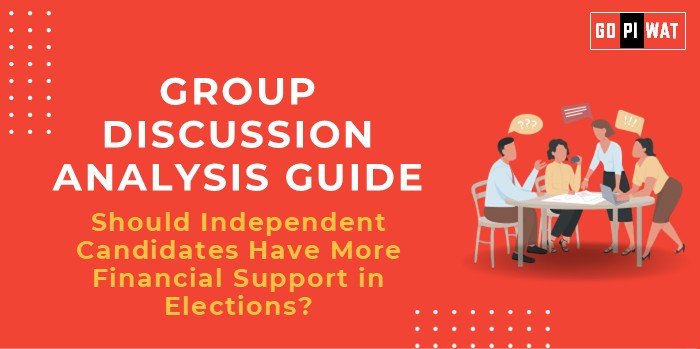📋 Group Discussion (GD) Analysis Guide: Should Independent Candidates Have More Financial Support in Elections?
🌐 Introduction to the Topic
- 📖 Context: Elections are the cornerstone of democratic governance, and financial support often determines candidates’ reach and influence. Party-backed candidates have established funding channels, while independents often struggle financially, raising questions about equity in democratic representation.
- 💡 Background: Independent candidates bring diverse perspectives to governance, but financial imbalance challenges fairness in elections. Transparency and equitable resource access are central to this debate.
📊 Quick Facts and Key Statistics
- 📉 Election Spending (2024): ₹60,000 crore in Lok Sabha elections (Election Commission of India) – highlights the growing costs of elections.
- 📊 Independent Candidates’ Success Rate: 1.07% in 2019 Lok Sabha elections – underscores financial and systemic challenges.
- 💰 Campaign Financing Gap: ₹200 crore declared by the top five national parties (ADR Report, 2023) – independent candidates have no similar collective fund pool.
- ⚖️ ECI Spending Cap: ₹95 lakh per Lok Sabha constituency (2024) – disproportionately favors organized party candidates.
🏛️ Stakeholders and Their Roles
- 🔍 Election Commission of India (ECI): Regulates campaign finance and ensures transparency.
- 🏛️ Political Parties: Dominate funding channels, often sidelining independents.
- 🗳️ Independent Candidates: Provide grassroots perspectives but lack robust financial backing.
- 👥 Citizens and Voters: Key beneficiaries of diverse representation and equitable elections.
- 🌱 NGOs and Advocacy Groups: Push for campaign finance reforms and equitable systems.
🏆 Achievements and Challenges
✨ Achievements:
- 🌐 Enhanced transparency through electoral bonds.
- 📢 Empowered regional voices in state assemblies.
- 🌱 Independent candidates often raise issues ignored by mainstream parties.
⚠️ Challenges:
- 💸 Financial dependency limits the reach of independents.
- ⚖️ Electoral bonds disproportionately benefit major parties.
- 📺 Limited media access for underfunded candidates.
🌍 Global Comparisons:
- 🇨🇦 Canada: Offers partial reimbursement for campaign expenses.
- 🇬🇧 UK: Caps individual donations, ensuring a level playing field.
Case Study: Kerala’s successful independent candidate movements have highlighted grassroots representation.
💬 Structured Arguments for Discussion
- ✅ Supporting Stance: “Providing financial support to independent candidates ensures a more inclusive democracy by bridging systemic gaps.”
- ❌ Opposing Stance: “Enhanced financial support may lead to misuse, complicating election monitoring and fairness.”
- ⚖️ Balanced Perspective: “While financial support is vital, it must be tied to accountability and transparency to prevent misuse.”
💡 Effective Discussion Approaches
- 🎯 Opening Approaches:
- 📈 Use impactful statistics, e.g., “Independent candidates have a mere 1.07% success rate in Lok Sabha elections due to financial constraints.”
- 🔍 Contrast approach: Highlight disparities between major parties and independents.
- 🛡️ Counter-Argument Handling:
- 🗨️ Example: “While funding misuse is a valid concern, strict regulatory mechanisms like public funding audits can mitigate such risks.”
📌 Strategic Analysis of Strengths and Weaknesses
- 🌟 Strengths: Diverse representation, grassroots focus, potential to disrupt corruption.
- ⚠️ Weaknesses: Limited organizational capacity, risk of fund misuse.
- 🌟 Opportunities: Global best practices like reimbursements or capped donations.
- ⚠️ Threats: Electoral influence by external or undisclosed sources.
📚 Connecting with B-School Applications
- 💼 Real-World Applications: Policy discussions, electoral strategy projects, or campaign finance models.
- 🗨️ Sample Interview Questions:
- 💡 How would you structure a funding model for independent candidates?
- 🌍 What lessons can India take from global practices in campaign finance?
- 📖 Insights for Students: Understand systemic inequities and propose innovative financial governance solutions.


